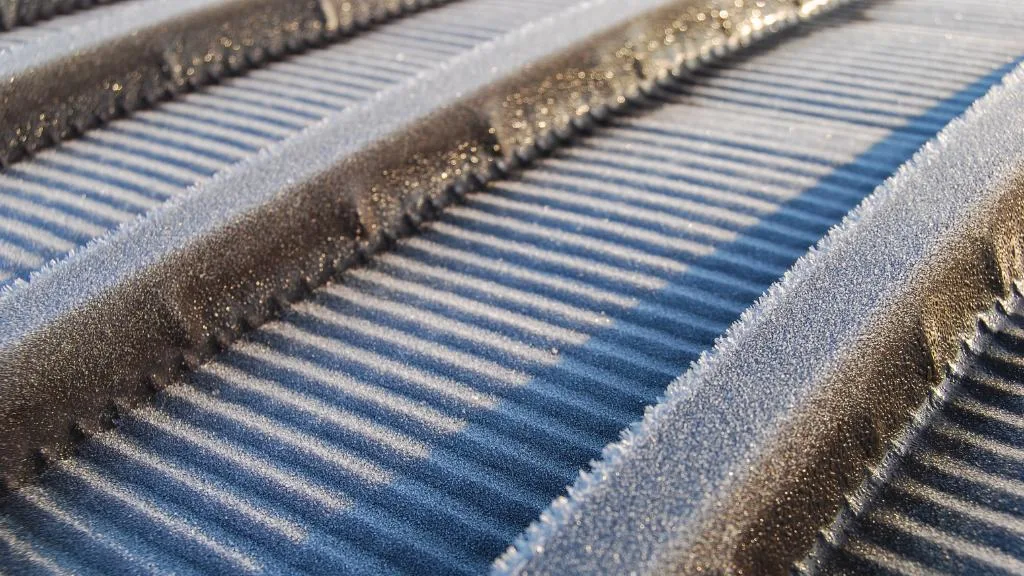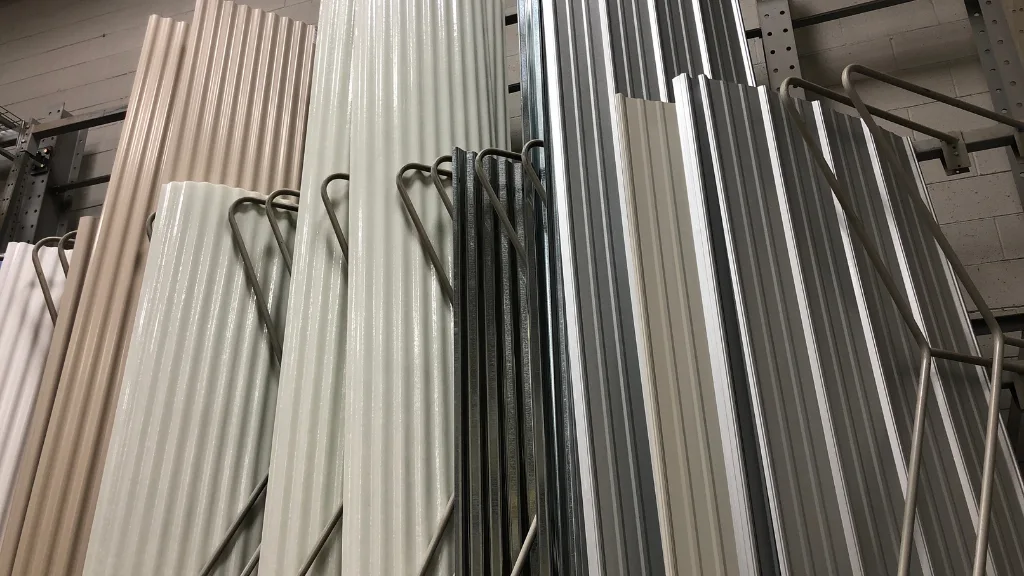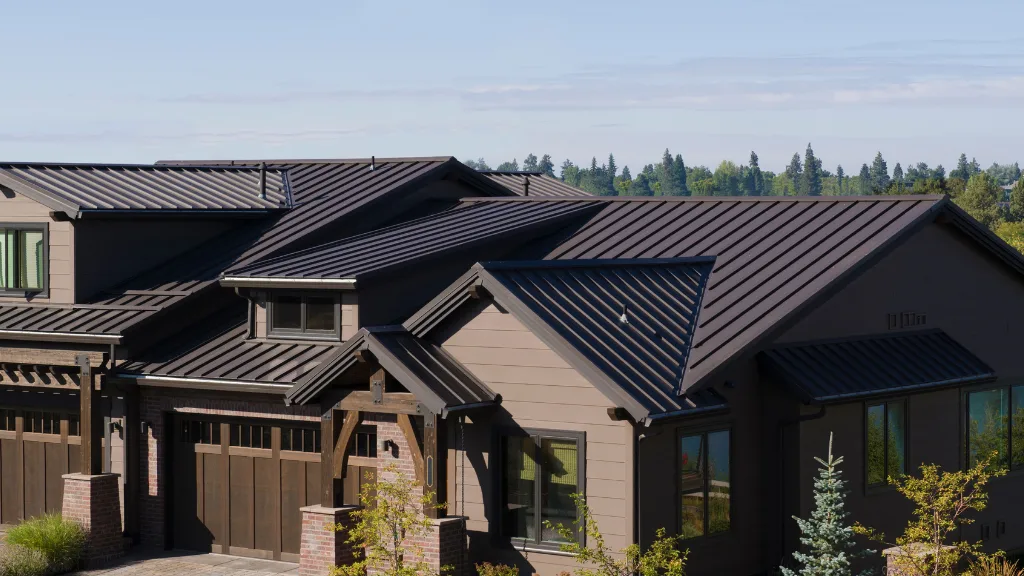
The variety of widths offered by metal roofs allows homeowners and builders alike to customize their construction projects according to their specific needs. In this article, we will explore the range of widths offered by different manufacturers.
How Wide Is Metal Roofing?
The standard metal roof panel width is between 24-36 inches. Most standard panels are between 8 feet and 12 feet in length with additional sizes available upon request. Although some manufacturers offer larger sheets up to 42 inches wide
With these dimensions accounted for, customers can easily create custom solutions tailored to their specific requirements while still adhering to safety standards.
Wider Metal Panel Widths Options
Metal roofing panels come in a wide variety of lengths and widths. Standard metal panel sizes vary from manufacturer to manufacturer, but the general rule is that wider sheets are more expensive than narrow sheets.
Standing seam metal roofs offer greater width options compared to other types of metal roofs. Wider standing-seam panels can be ordered with two or three ribs per panel, depending on the desired aesthetic look and the location of installation.
These wider panels may also require additional support due to their increased weight and span capabilities.
In addition, there are some classic rib metal roofs that offer even wider panel profiles than what is available in most standing seam models.
The larger profile requires fewer seams which results in improved energy efficiency as well as making it easier for installers to handle large pieces instead of multiple small ones.
Despite this benefit, these extra wide panels cost significantly more than narrower versions and may not fit certain budget constraints for an entire roof replacement project.

Sizes Of Classic Rib Metal Roofing Panels
Metal roofing is typically measured in square footage, making it easy to determine the amount of material needed for a project.
Generally speaking, most classic rib metal roof panels range from 3′ to 12′ wide and are available in lengths up to 40′.
This provides homeowners with plenty of options when choosing their preferred style and size. Here is an overview of sizes of classic rib metal roofing panels that are commonly used:
- Standing Seam Metal Roof Panels: These come in widths ranging from 14″ – 24″.
- Corrugated Metal Roofing: These usually measure 2′-4′ wide with depths varying between 1/2” – 1 ½”.
- Metal Roof Panels: Available in widths measuring 4′-8′, these panels require minimal maintenance and provide excellent coverage over large areas.
- Square Footage Coverage: The number of metal roof panels necessary depends upon the desired coverage area; however, one panel can cover up to 10 square feet or more depending on its size.
It’s important to note that there may be slight variations in size when purchasing pre-fabricated sheets as opposed to custom order materials.
As such, it’s always best practice to consult with a professional installer before committing to any particular option. Additionally, some manufacturers offer special sizing services where customers can customize the length and width of each panel according to their specific requirements.
With so many varieties and sizes available today, homeowners have more choices than ever before when selecting a metal roof for their home.
Sizes Of Corrugated Metal Roof Panels
The sizes of corrugated metal roof panels vary depending on the type and style. Metal shingles, for example, are typically available in 12” widths or 24” widths.
Standing seam metal roof panel systems come with a standard coverage width of 16″.
Corrugated steel panels usually have a rib height of 2″ to 3″, while some can measure up to 5″ tall. The overall width of the metal sheet may range from 36” to 48” wide.
| Panel Style | Width (inches) | Coverage Width (inches) |
|---|---|---|
| Metal Shingles | 12 or 24 | N/A |
| Standing Seam | N/A | 16 |
| Corrugated | 36-48 | 2-5 |
Although there is no one size that fits all when it comes to corrugated metal roofs, most homeowners will find that the typical panel dimensions provide enough coverage to meet their needs.
Furthermore, they offer superior performance and protection against extreme weather conditions such as strong winds and heavy rainfall.
As such, these types of roofing materials are ideal for those seeking an affordable yet reliable solution for their home’s exterior.

Frequently Asked Questions
What Are The Benefits Of Metal Roofing?
Metal roofing has come to be seen as a practical and cost-effective solution for many homes, businesses, and other structures.
With increased durability, longevity, reduced energy costs, and improved aesthetics, these roofs are quickly becoming the go-to choice for those looking to upgrade their dwellings.
Firstly, metal roofs can last up to two or three times longer than traditional asphalt shingle roofs due to their superior strength and resilience against inclement weather conditions such as high winds and hail storms.
Furthermore, they reflect more sunlight than regular roofs which helps keep temperatures cooler during hot summer days while also offering better insulation at night when temperatures drop significantly.
This translates into lower energy bills over time since your home won’t require nearly as much electricity to maintain its temperature level year round.
In addition to being highly durable and providing excellent thermal control properties, metal roofs offer tremendous aesthetic appeal with contemporary colors ranging from classic gray all the way through deep reds shades that blend well with virtually any property’s design theme.
Plus, modern coatings make them resistant to corrosion so you don’t have worry about rust damaging your investment down the line.
All of these features combine together to create a cost effective alternative that yields long lasting results without sacrificing quality or style.
How Much Does Metal Roofing Cost?
Metal roofing is an economical and efficient option for any home or commercial building. It offers a range of benefits, such as increased durability, protection from the elements, energy efficiency and aesthetic appeal.
The cost of metal roofing can vary greatly depending on factors such as size of the roof, type of material used, and installation method.
The most commonly used materials for metal roofing are steel and aluminum. Steel requires more maintenance than aluminum but is more durable in harsh climates.
Aluminum is lightweight and has good corrosion resistance, making it suitable for coastal regions with high humidity levels.
Prices per square foot will depend on the gauge of steel or thickness of aluminum being used; thicker gauges and higher-grade alloys may require additional costs.
In addition to the price of materials, labor costs should be taken into consideration when estimating total expenses.
Professional installation ensures that your new metal roof is installed correctly according to local building codes and manufacturer’s recommendations.
As experienced professionals typically charge by the hour or day rate plus materials, this could significantly add to your overall budget if you hire them instead of attempting do-it-yourself installation methods which may void warranties or even cause damage to your property due to improper techniques being employed.
When considering whether metal roofing is right for you, other important factors include:
- Durability: Metal roofs have been known to last up to 50 years compared to traditional asphalt shingle roofs lasting around 20 years before needing replacement.
- Weather Resistance: Metal roofs provide superior protection against rainwater runoff during heavy precipitation events while also shielding against hail damage and ultraviolet radiation exposure over time.
- Energy Efficiency: Metal roofs reflect heat away from buildings rather than absorbing it like traditional asphalt shingle roofs resulting in lower cooling bills throughout hot months and warmer temperatures inside during winter months due to their improved insulation properties.
Metal Roofing provides many advantages including long life span, weatherproof capabilities and energy savings – all at an affordable cost when taking into account both materials needed for installation as well as professional labor costs associated with employing qualified installers who guarantee quality workmanship along with valid product warranties offered by manufacturers
What Is The Lifespan Of A Metal Roof?
The lifespan of a metal roof is one of its most attractive features. It can last for decades, providing a strong and reliable shelter to any structure it covers. In fact, it has been known to outlive the building structures that are beneath it.
A quality metal roof will not only last longer but also stand up better against extreme weather conditions like heavy rains and snowfall.
The right type of installation techniques will go a long way towards ensuring optimal performance over time since they help reduce the risk of leaks and water damage.
Furthermore, many manufacturers offer warranties ranging from 20 years onwards so customers have peace of mind when making their purchase decisions.
Additionally, some even provide maintenance agreements which guarantee regular inspections and replacement services if required.
Metal roofs can also prove to be cost effective solutions in terms of energy savings due to their reflective properties that help keep interior temperatures stable throughout different seasons; thus reducing reliance on heating systems during winter months while keeping them cool in summertime climates.
This makes them ideal candidates for those who seek greater control over their utility bills without sacrificing comfort levels within their homes or businesses buildings alike.
All things considered, it is easy to understand why metal roofing continues to remain popular choice among homeowners worldwide despite the upfront costs associated with installation or repair works being higher compared to other materials available today.
Is Metal Roofing Fire Resistant?
Metal roofing is an increasingly popular choice for residential and commercial buildings due to its long life expectancy, low maintenance requirements and potential energy savings. It also has the added benefit of being fire resistant – a critical factor in any construction project.
The fire resistance of metal roofs depends on a few factors: 1) The type of metal used: Steel, aluminum or copper are most common; 2) The coating applied to the metal roof: Paint, zinc or polyester-based are all options; 3) The installation method utilized to secure the roof. Professionally installed standing seam metal roofs have been shown to perform exceptionally well against fires.
When it comes to protecting your home from fire damage, there’s no substitute for quality workmanship and durable materials – both of which can be found with metal roofing systems.
Not only does this provide peace of mind that your home will remain safe during even the toughest conditions but you can rest assured knowing that you’re making an environmentally friendly decision as well!
Metal roofing is 100% recyclable, requires minimal maintenance compared to other materials and reflects up to 70 percent of solar radiation away from structures helping reduce cooling costs significantly over time.
Overall, when considering an option for durable protection against fire while also benefiting from efficiency and sustainability advantages through reduced lifetime ownership costs, metal roofing should always be at the top of your list.
With expert installation practices and proper care, these benefits make installing a metal roof one of the smartest investments homeowners can make today.
Is Metal Roofing Easy To Install?
Installing metal roofing can be a great way to protect your home and increase its value. It is also an efficient and cost-effective option when compared to traditional shingle roofs. As such, many homeowners are deciding to install metal roofs despite the installation process being more complex than other types of roofing materials.
The complexity of installing metal roofing lies in its material composition – steel or aluminum sheets that need to be cut into specific sizes before they can be fitted onto the structure of the house.
This requires precision measurements as well as manual labor for cutting and fitting each piece together so that it fits perfectly on the surface area.
In addition, there may be additional requirements depending on the type of construction such as making sure all seams are properly sealed with sealant and fasteners are securely attached in order to ensure a strong connection between panels. Another popular question when it comes to installation is can you overlap metal roof lengthwise? Fortunately, professional help is available from certified contractors who specialize in this type of work and have years of experience doing similar jobs.
Not only will they make sure everything is done right but also save you time by completing the job quickly while adhering to safety standards set forth by local building codes.
With their help, you can rest assured that your new metal roof will not only look beautiful but also provide protection against extreme weather conditions for years to come.
Conclusion
Metal roofing is becoming increasingly popular due to its many benefits. It is fire-resistant, cost-efficient, and can last up to five times longer than other traditional roofing materials such as asphalt shingle roofs. Additionally, it is relatively easy to install and requires minimal maintenance over the years.
The width of metal roofing panels varies depending on the specific type selected for a project. Panels are typically either 12 inches or 16 inches in width with lengths ranging from 3 feet to 45 feet long.
As an example, a typical standing seam panel used in residential construction would be around 16 inches wide by 36 feet long. The most commonly used steel material thicknesses range between 24 gauge and 26 gauge but could vary based on the application requirements.
Overall, metal roofing offers numerous advantages for homeowners interested in durable and attractive options for their home’s exterior. Its average lifespan of 40–70 years far exceeds that of other conventional materials while providing superior protection against extreme weather conditions such as hail and high winds.
In fact, studies have shown that metal roofs can withstand wind gusts up to 140 miles per hour – making them one of the most reliable forms of roofing available today!

